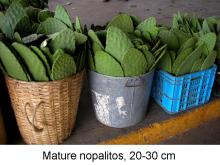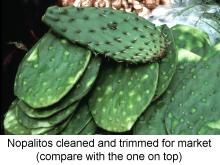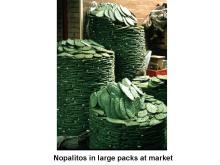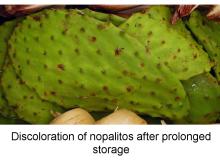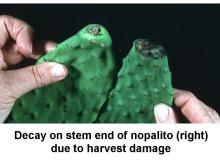Índices de madurez
Cactus stems or "nopalitos" (in Spanish) are the rapidly-growing succulent stems of the Prickly Pear Cactus (Opuntia spp). They are grown in California as a specialty vegetable or imported from Mexico, where they are a traditional vegetable. Cactus stems are harvested based on size, and can be harvested small
Good quality nopalitos are fresh, turgid and a brilliant green color. Nopalitos should be harvested when young and tender and not early in the morning to avoid a high acid content (see special considerations).
Manejo y almacenamiento poscosecha
Generally nopalitos should be cooled to about 5°C (41°F) to reduce loss of visual appearance due to water loss. The recommended conditions for storage of nopalitos are 5°C to 10°C (41°F to 50°F) at high relative humidity. The major factors limiting storage life of nopalitos are decay and dehydration. Nopalitos stored under higher temperatures rapidly loss their brilliant shiny appearance, become dull green and may also begin to yellow and curve inward due to water loss. Good quality can be maintained for
| Temperature | 5°C (41°F) | 10°C (50°F) | 15°C (59°F) | 20°C (68°F) |
| ml CO2/kg·hr | 8-10 | 20-22 | 28-32 | 38-44 |
To calculate heat production multiply ml CO2/kg·hr by 440 to get Btu/ton/day or by 122 to get kcal/metric ton/day.
These are average respiration rates for 10 cm nopalitos; respiration rates of 20cm stems are about 50% lower.
Nopalitos are not very sensitive to ethylene exposure, but exposure at warmer temperatures will enhance yellowing.
90-95%
Ethylene production rates are very low (0.05, 0.10 and 0.20 µl/kg·hr at 5°C (41°F), 10°C (50°F) and 20°C (68°F), respectively).
No information is available on the potential benefits of modified/controlled atmosphere storage of cactus stems. For diced product, moderate CO2 (5-10%) atmospheres may be beneficial.
Desórdenes
Chilling injury. Nopalitos are chilling sensitive when stored below 10°C (50°F) . However, 3 weeks at 5°C (41°F) may be needed to observe some chilling symptoms. Chilling damage may be manifested as a superficial bronzing or discoloration and increased susceptibility to decay. The onset of chilling injury will depend on storage temperature, maturity and source of product.
Decay at the cut stem end may be a problem if nopalitos are stored for longer than 2 weeks. Decay is usually avoided by insuring that the nopalitos have not been damaged when cut from the plant. Decay can also occur during storage at places where spines have penetrated the surface.
Special Considerations
Cactus stems should be harvested and handled with care to avoid mechanical damage, especially due to spines from one stem penetrating the neighboring stem. Spine damage leads to a rusty-brown discoloration and pathological problems.
Because of the spines, a cleaned and diced product is an attractive option. The cut nopalitos cannot be washed before marketing because it will cause mucilage to exude and increase discoloration of the cut surfaces. Cleaned and diced nopalitos should be stored between 0°C (32°F) and 5°C (41°F) and have a shelf-life of about 6 days.
Because the prickly pear plant is a CAM plant (Crassulacean Acid Metabolism) and fixes CO2 at night as malic acid before converting it to sugars during the day, the acid content of nopalitos may fluctuate greatly and affect their flavor. Therefore it is recommended to harvest the stems after 2-3 hours of sunlight. Small nopalitos however, are not CAM-active. In addition, low storage temperatures 5°C (41°F) maintain acid levels.



